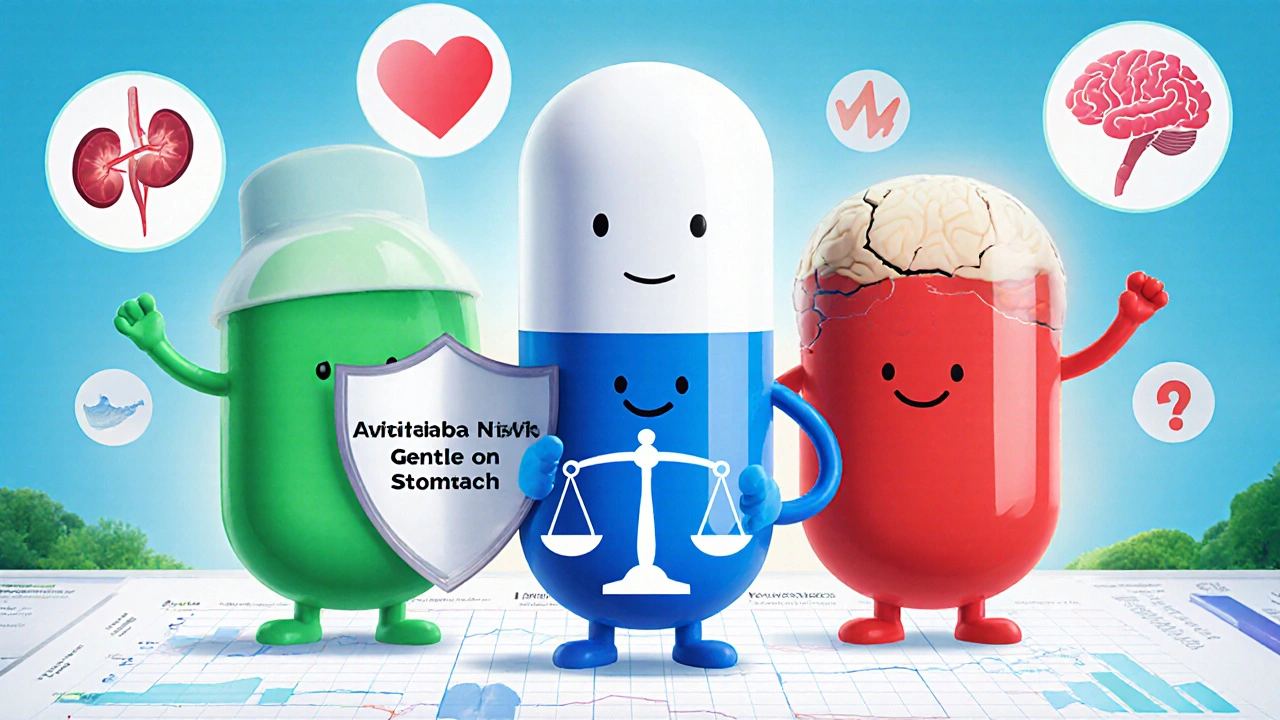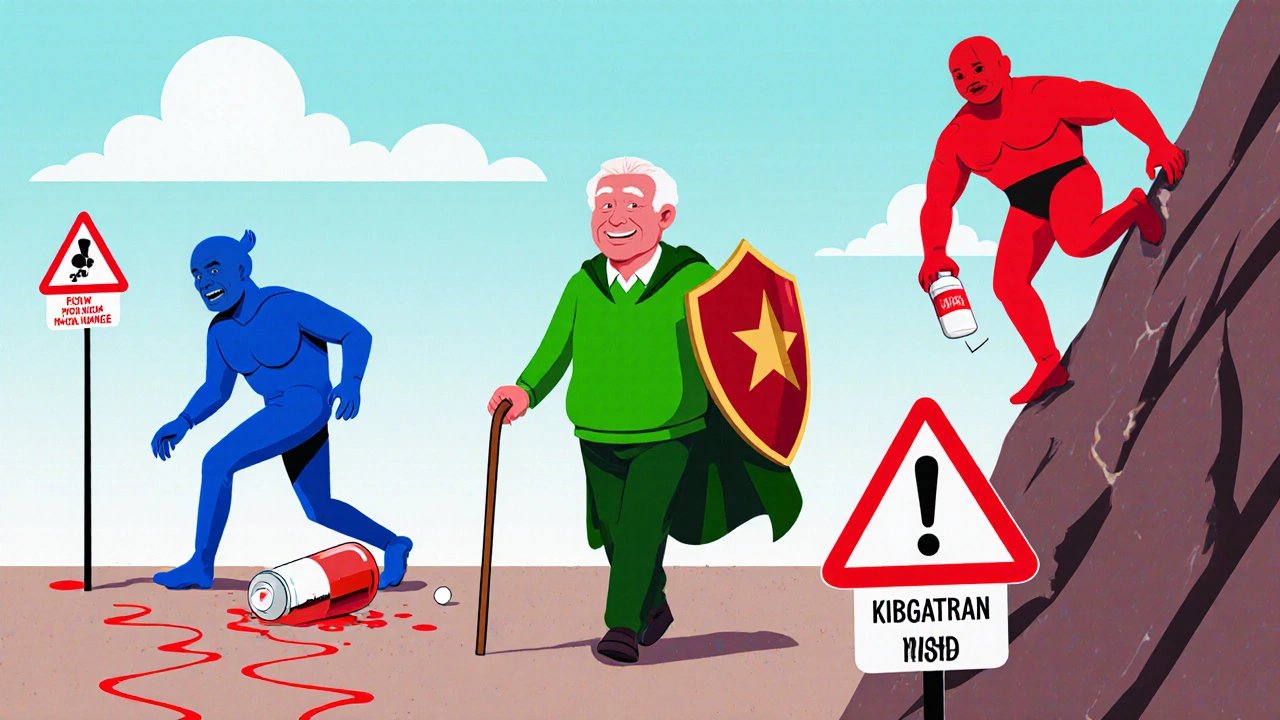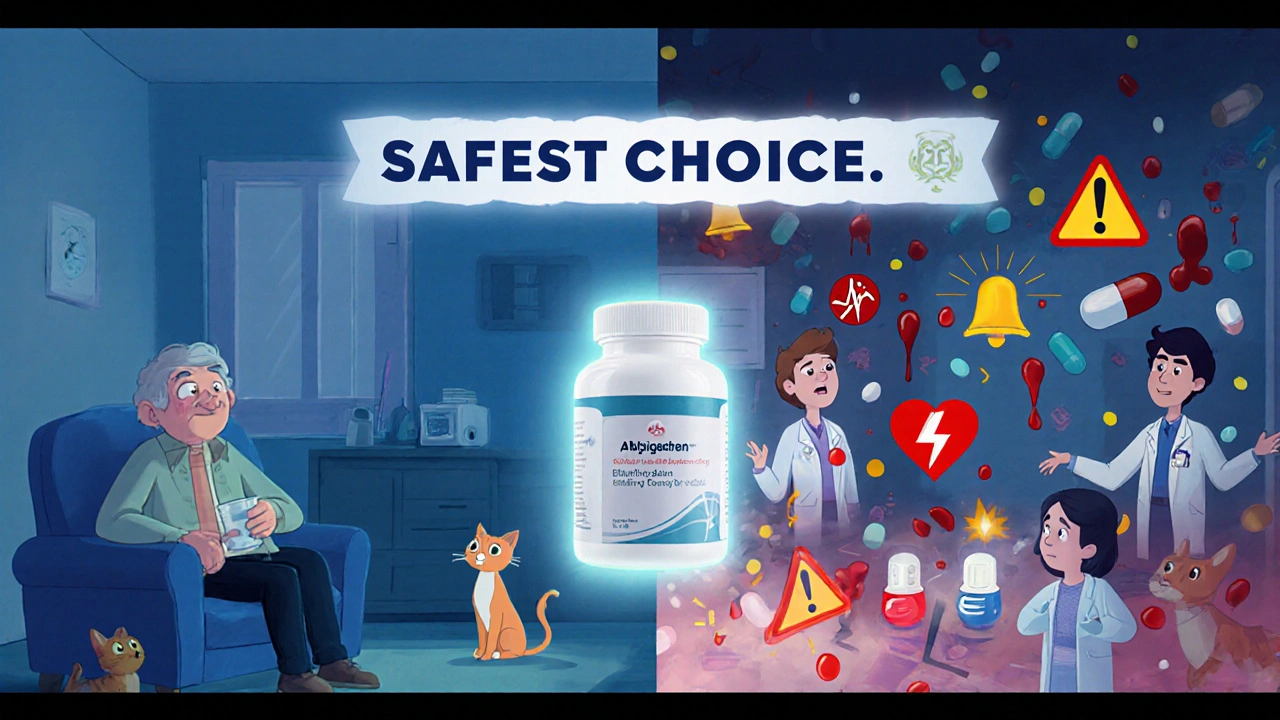Apixaban vs Rivaroxaban vs Dabigatran: Key Side Effect Differences You Need to Know

DOAC Comparison Tool
This tool helps you understand which of the three direct oral anticoagulants (DOACs) — apixaban (Eliquis), rivaroxaban (Xarelto), and dabigatran (Pradaxa) — might be safest for your individual health profile based on real-world data from hundreds of thousands of patients.
Recommended Option
When you're prescribed a blood thinner, you're not just getting a pill-you're getting a trade-off. Each one has its own risks, and knowing which one matches your body and lifestyle can make a real difference in your safety. Apixaban, rivaroxaban, and dabigatran are the three most common direct oral anticoagulants (DOACs) used today. They're meant to prevent strokes in people with atrial fibrillation and treat blood clots in the legs or lungs. But they don't all act the same. One might be safer for your stomach. Another might lower your chance of brain bleeding. And one could raise your risk of a heart attack. This isn't guesswork. Real-world data from hundreds of thousands of patients shows clear, consistent patterns.
Why These Three Matter
Before DOACs, warfarin was the only option. You had to get regular blood tests, watch what you ate, and deal with dozens of drug interactions. Apixaban (Eliquis), rivaroxaban (Xarelto), and dabigatran (Pradaxa) changed that. They don’t need constant monitoring. They work faster. And they’re easier to take. But they’re not interchangeable. Each one blocks a different part of the clotting system. Dabigatran stops thrombin. Apixaban and rivaroxaban stop factor Xa. That small difference in how they work leads to big differences in what side effects you might get.
Gastrointestinal Bleeding: The Biggest Difference
If you’ve ever had a stomach ulcer, take NSAIDs like ibuprofen, or have a history of GI bleeding, this is the most important thing to know: apixaban has the lowest risk of bleeding in your digestive tract.
Studies tracking over 300,000 patients found that rivaroxaban causes nearly twice as many GI bleeds as apixaban. One JAMA study showed 39.7 major GI bleeds per 1,000 people per year with rivaroxaban-versus just 16.3 with apixaban. That’s a 2.1 times higher risk. Dabigatran isn’t far behind, with about 35 bleeds per 1,000 people per year. Apixaban? Only 16.3. That’s not a small gap. It’s the difference between a 1 in 25 chance and a 1 in 60 chance over a year.
Why? It’s not fully understood, but it might be because apixaban is less concentrated in the gut lining. Rivaroxaban and dabigatran seem to irritate the stomach lining more. If you’re over 80, have kidney issues, or take aspirin or NSAIDs, this difference becomes even more critical. For those patients, apixaban is often the top choice-not because it’s stronger, but because it’s gentler on the stomach.
Major Bleeding: Not All Are Equal
Major bleeding means any bleed that needs a hospital visit, transfusion, or causes a drop in hemoglobin. This includes bleeding in the brain, gut, or other organs. Here’s where the data gets even clearer: rivaroxaban carries the highest risk. Apixaban has the lowest.
The same JAMA study showed rivaroxaban caused 39.7 major extracranial bleeds per 1,000 person-years. Apixaban? Only 18.5. That’s a 2.1 times higher risk with rivaroxaban. Dabigatran sits in the middle. Even when you adjust for age, kidney function, and other conditions, apixaban consistently comes out on top for safety.
That’s why doctors in Canada, the U.S., and Europe now recommend apixaban as the first-line choice for most patients-especially older adults or those with a history of falls. It’s not about being the strongest. It’s about being the safest.

Brain Bleeds: The Unexpected Twist
You’ve probably heard that all DOACs are better than warfarin at preventing brain bleeds. That’s true. But here’s the surprise: among the DOACs, rivaroxaban might actually be the safest for your brain.
A 2022 head-to-head study found rivaroxaban had a 14% lower risk of intracranial hemorrhage compared to apixaban. That’s counterintuitive. Apixaban is safer for your stomach and overall bleeding, but rivaroxaban might protect your brain slightly better. Dabigatran also shows lower brain bleeding rates than rivaroxaban in some studies-especially at the 110 mg dose.
So if you’re at high risk for falling-maybe you have balance issues, Parkinson’s, or live alone-apixaban is still the overall safest bet. But if your biggest fear is a brain bleed from a head injury, rivaroxaban might be worth discussing. This isn’t a dealbreaker, but it’s a nuance most patients and even some doctors miss.
The Hidden Risk: Heart Attacks and Chest Pain
This one catches people off guard. Dabigatran is linked to a higher risk of heart attacks and acute coronary syndrome. Multiple studies, including meta-analyses of over 50,000 patients, show a 48% higher relative risk compared to rivaroxaban and apixaban.
Why? Scientists think dabigatran’s way of blocking thrombin might trigger inflammation in the arteries-similar to a drug called ximelagatran that was pulled from the market for causing liver damage and heart problems. It’s not common, but it’s real. If you have a history of heart disease, angina, or a previous heart attack, dabigatran might not be the best choice. Apixaban and rivaroxaban don’t show this same signal.
That’s one reason dabigatran’s market share has dropped from nearly 30% in 2015 to under 10% today. Doctors are choosing alternatives with fewer cardiac risks.
Renal Function: Kidneys Decide the Dose
Your kidneys clear these drugs from your body. But they do it differently.
- Dabigatran: 80% cleared by kidneys. If your kidney function drops below 30 mL/min, you can’t take the standard 150 mg dose. At under 15 mL/min, you can’t take it at all.
- Rivaroxaban: 33% cleared by kidneys. You can still use it with moderate kidney disease, but dose adjustments are needed.
- Apixaban: Only 25% cleared by kidneys. That’s why it’s the go-to for older patients with kidney decline. Even if your creatinine clearance is 15-25 mL/min, you can still take apixaban safely at a lower dose.
For patients over 75 with mild kidney trouble, apixaban is often the only DOAC that doesn’t require stopping or reducing the dose. Rivaroxaban and dabigatran become risky or impossible to use safely.

Dosing and Daily Life
Apixaban: Take twice daily, with or without food. No need to time it with meals.
Rivaroxaban: Once daily for atrial fibrillation. But if you’re treating a blood clot, you need to take it twice daily-and always with food. Missing a dose or forgetting to eat with it can make it less effective.
Dabigatran: Twice daily, no food needed. But the capsules must be swallowed whole. You can’t open, crush, or chew them. That’s a problem for people with swallowing issues or those on feeding tubes.
Adherence matters. A once-daily pill is easier to remember. But if you take rivaroxaban without food, it won’t work as well. Apixaban’s twice-daily schedule is less convenient, but it’s more forgiving if you miss a dose.
What Should You Choose?
There’s no one-size-fits-all. But here’s how to think about it:
- Choose apixaban if: You’re over 75, have kidney issues, a history of stomach ulcers, take NSAIDs, or are worried about bleeding anywhere in your body. It’s the safest overall.
- Choose rivaroxaban if: You struggle with taking pills twice a day, have normal kidneys, and your biggest concern is brain bleeding. But avoid it if you’ve had a GI bleed or have heart disease.
- Avoid dabigatran if: You have heart disease, a history of heart attack, or kidney function below 30 mL/min. It’s still an option for young, healthy patients with no cardiac history-but it’s no longer the first pick.
Cost is also a factor. Generic apixaban now costs under $20 a month in Canada and the U.S. Rivaroxaban and dabigatran generics are similarly priced. So safety, not price, should drive your choice.
Bottom Line
Apixaban wins on safety across the board-less GI bleeding, less major bleeding, fewer heart risks, and better kidney tolerance. Rivaroxaban’s once-daily dosing helps with adherence, but at the cost of higher bleeding risk. Dabigatran’s kidney dependence and heart risks make it the least preferred for most patients today.
Doctors used to treat all DOACs like they were the same. Now we know better. The right one for you depends on your kidneys, your stomach, your heart, and your daily routine. Don’t assume your prescription is the best one. Ask: Why this one? Is there a safer option? You have the right to know the differences-and the right to choose the one that fits your life best.
Which blood thinner has the least side effects?
Apixaban has the lowest risk of major bleeding, gastrointestinal bleeding, and heart-related side effects compared to rivaroxaban and dabigatran. It’s also safer for people with kidney problems. For most patients, especially older adults or those with a history of ulcers or falls, apixaban is the safest option.
Can I switch from rivaroxaban to apixaban?
Yes, switching is common and often recommended if you’re at high risk for bleeding or have kidney issues. Your doctor will stop your current medication and start apixaban the next day, without needing a bridge with heparin. Studies show it’s safe and effective. Many patients report fewer stomach issues after switching.
Does dabigatran cause more heart attacks?
Yes, multiple studies show dabigatran is linked to a 48% higher relative risk of heart attack or acute coronary syndrome compared to apixaban and rivaroxaban. The exact reason isn’t clear, but it may be related to how it affects inflammation in blood vessels. If you have heart disease, it’s generally avoided.
Is apixaban better for elderly patients?
Yes. Apixaban is the preferred DOAC for patients over 80. It has the lowest risk of bleeding, even in those with reduced kidney function. Studies show elderly patients on apixaban have fewer hospitalizations for bleeding and lower death rates compared to those on rivaroxaban or dabigatran.
Why is rivaroxaban still prescribed if it has more side effects?
Rivaroxaban is still used because it’s once daily, which helps with adherence. Some patients find it easier to remember one pill a day. It’s also a good option for those with normal kidney function and no history of stomach bleeding. But it’s no longer the first choice for most patients-especially not for older adults or those with risk factors.
Do I need blood tests while on these medications?
No, routine blood tests like INR aren’t needed for apixaban, rivaroxaban, or dabigatran. That’s one of their main advantages over warfarin. However, your doctor may check your kidney function once or twice a year to make sure your dose is still safe.






Deepak Mishra
November 15, 2025 AT 02:24So apixaban is the safest?? 😅 But wait-what if your kidneys are fine but you’re a clumsy human who trips over air?? Then rivaroxaban’s brain bleed protection might be the real MVP?? 🤯 I’m just saying… don’t let the hype blind you!
Oyejobi Olufemi
November 15, 2025 AT 11:43Apixaban is NOT the answer-it’s corporate propaganda disguised as science! The FDA’s been bought off by Bristol-Myers! Look at the data sources-they’re all funded by the same pharma conglomerates! Dabigatran’s heart risk? That’s a red herring! They’re hiding the truth because they don’t want you switching to cheaper generics! I’ve seen patients on apixaban develop unexplained bruising-no one talks about that! You’re being manipulated! 😡
Teresa Smith
November 16, 2025 AT 17:34People keep saying apixaban is the safest-but what does that even mean? Safer for whom? For a 90-year-old with renal decline? Yes. For a 45-year-old athlete with a history of GI ulcers? Maybe not. We’re reducing complex biology to a single pill label. That’s dangerous. You need to know your own body-not just the headline. This isn’t a race. It’s a personalized puzzle.
David Rooksby
November 16, 2025 AT 23:35Let’s be real-rivaroxaban’s once-daily thing is a trap. I’ve seen so many people miss doses because they ‘forgot’ and then end up in the ER with a clot. And don’t even get me started on taking it with food-‘oh, I had a protein shake’-that’s not the same as a proper meal. Apixaban’s twice a day is annoying but it’s forgiving. One missed dose? No biggie. Rivaroxaban? You’re playing Russian roulette with your circulation. And the brain bleed thing? That’s just noise. You’re way more likely to die from a GI bleed than a fall-induced intracranial hemorrhage. Don’t get seduced by the ‘cool’ once-daily marketing.
Melanie Taylor
November 17, 2025 AT 19:40OMG I just switched from rivaroxaban to apixaban last month and my stomach hasn’t felt this good since 2018!! 🙌 No more burning after lunch, no more ‘is this gas or a bleed?’ anxiety!! Also my nephrologist said my eGFR is stable-no dose tweaks needed!! Apixaban is the quiet hero we don’t talk about enough 💖
ZAK SCHADER
November 17, 2025 AT 19:40Apixaban is fine for Americans but in the real world we don’t have the luxury of choosing. My cousin in India got stuck with dabigatran because it’s cheaper and the doctor didn’t care. You think this is about science? Nah. It’s about who’s got the best sales rep. Wake up.
Danish dan iwan Adventure
November 19, 2025 AT 11:39DOACs are all non-inferior. Meta-analyses show no significant mortality difference. Apixaban’s GI safety advantage is marginal in real-world cohorts. You’re overinterpreting subgroup analyses. Stick to guidelines.
Ankit Right-hand for this but 2 qty HK 21
November 20, 2025 AT 21:11Apixaban? More like Apixab*an*-a scam designed to make you think you’re safe while the real killer is the systemic inflammation from corporate healthcare. Dabigatran’s heart risk? That’s just the tip. They’re all designed to keep you dependent. The real solution? Natural blood thinners. Turmeric. Garlic. Stop trusting Big Pharma.
Daniel Stewart
November 22, 2025 AT 05:14It’s funny how we treat these drugs like they’re interchangeable. They’re not. But neither are we. Each patient is a unique ecosystem. The real question isn’t which drug is best-it’s which one aligns with your daily rhythm, your fears, your body’s quiet signals. We’ve turned medicine into a spreadsheet. That’s the tragedy.
Latrisha M.
November 23, 2025 AT 15:36Apixaban is the most forgiving for kidney function and bleeding risk. That’s the data. If you’re over 75 or on NSAIDs, it’s the obvious choice. No need to overthink it. Just talk to your doctor about your specific risks and go with the evidence.
Diane Tomaszewski
November 23, 2025 AT 16:53I’ve been on rivaroxaban for three years and never had a problem. I take it with dinner every night. No issues. Why does everyone act like it’s a ticking bomb? Maybe the data is skewed because people with ulcers get pushed to apixaban from the start. Maybe the comparison isn’t fair.
Jamie Watts
November 24, 2025 AT 17:32Apixaban wins. Period. The numbers don’t lie. Rivaroxaban’s GI bleed risk is insane. Dabigatran’s heart risk is a red flag. If you’re not on apixaban and you’re over 65 or have any kidney issues you’re basically gambling. Stop being a hero. Take the safer pill.
Rachel Wusowicz
November 24, 2025 AT 21:19What if… what if all of this is a distraction? What if the real problem isn’t which pill you take-but why you needed a blood thinner in the first place? Why is atrial fibrillation so common? Why are we treating symptoms and not causes? The food, the stress, the sedentary lives… we’re all just trying to outsmart a system that made us sick. Apixaban might save your life today… but who’s saving your life tomorrow?
Dan Angles
November 25, 2025 AT 08:34Thank you for this comprehensive and evidence-based overview. The data presented aligns with current clinical guidelines from the American College of Cardiology and the European Society of Cardiology. It is imperative that patients understand the nuanced risk-benefit profiles of these agents. Apixaban remains the preferred agent for most populations, particularly those with advanced age, renal impairment, or a history of gastrointestinal bleeding. Clinicians should individualize therapy based on patient-specific factors, including adherence potential, comorbidities, and concomitant medications. This level of detail is precisely what is needed to move beyond one-size-fits-all prescribing.